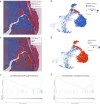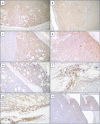Spatial Transcriptomics in a Case of Follicular Thyroid Carcinoma Reveals Clone-Specific Dysregulation of Genes Regulating Extracellular Matrix in the Invading Front
- PMID: 38280140
- PMCID: PMC11176252
- DOI: 10.1007/s12022-024-09798-0
Spatial Transcriptomics in a Case of Follicular Thyroid Carcinoma Reveals Clone-Specific Dysregulation of Genes Regulating Extracellular Matrix in the Invading Front
Abstract
Follicular thyroid carcinoma (FTC) is recognized by its ability to invade the tumor capsule and blood vessels, although the exact molecular signals orchestrating this phenotype remain elusive. In this study, the spatial transcriptional landscape of an FTC is detailed with comparisons between the invasive front and histologically indolent central core tumor areas. The Visium spatial gene expression platform allowed us to interrogate and visualize the whole transcriptome in 2D across formalin-fixated paraffin-embedded (FFPE) tissue sections. Four different 6 × 6 mm areas of an FTC were scrutinized, including regions with capsular and vascular invasion, capsule-near area without invasion, and a central core area of the tumor. Following successful capturing and sequencing, several expressional clusters were identified with regional variation. Most notably, invasive tumor cell clusters were significantly over-expressing genes associated with pathways interacting with the extracellular matrix (ECM) remodeling and epithelial-to-mesenchymal transition (EMT). Subsets of these genes (POSTN and DPYSL3) were additionally validated using immunohistochemistry in an independent cohort of follicular thyroid tumors showing a clear gradient pattern from the core to the periphery of the tumor. Moreover, the reconstruction of the evolutionary tree identified the invasive clones as late events in follicular thyroid tumorigenesis. To our knowledge, this is one of the first 2D global transcriptional mappings of FTC using this platform to date. Invasive FTC clones develop in a stepwise fashion and display significant dysregulation of genes associated with the ECM and EMT - thus highlighting important molecular crosstalk for further investigations.
Keywords: FTC; Invasion; Phylogenetics, Extracellular matrix; Spatial transcriptomics.
© 2024. The Author(s).
Conflict of interest statement
The authors declare no competing interests.
Figures




Similar articles
-
Expression of epithelial-mesenchymal transition regulators TWIST, SLUG and SNAIL in follicular thyroid tumours may relate to widely invasive, poorly differentiated and distant metastasis.Histopathology. 2019 Apr;74(5):780-791. doi: 10.1111/his.13778. Epub 2019 Mar 10. Histopathology. 2019. PMID: 30368884
-
Microarray analysis of formalin-fixed, paraffin-embedded follicular thyroid carcinoma samples from patients who developed postoperative distant metastasis.BMC Res Notes. 2020 May 13;13(1):241. doi: 10.1186/s13104-020-05080-8. BMC Res Notes. 2020. PMID: 32404135 Free PMC article.
-
Hypoxia Induces Epithelial-Mesenchymal Transition in Follicular Thyroid Cancer: Involvement of Regulation of Twist by Hypoxia Inducible Factor-1α.Yonsei Med J. 2015 Nov;56(6):1503-14. doi: 10.3349/ymj.2015.56.6.1503. Yonsei Med J. 2015. PMID: 26446630 Free PMC article.
-
RAS-Mutant Follicular Thyroid Tumors: A Continuous Challenge for Pathologists.Endocr Pathol. 2024 Sep;35(3):167-184. doi: 10.1007/s12022-024-09812-5. Epub 2024 Jun 18. Endocr Pathol. 2024. PMID: 38888731 Review.
-
Macrofollicular Variant of Follicular Thyroid Carcinoma (MV-FTC) with a Somatic DICER1 Gene Mutation: Case Report and Review of the Literature.Head Neck Pathol. 2021 Jun;15(2):668-675. doi: 10.1007/s12105-020-01208-1. Epub 2020 Jul 25. Head Neck Pathol. 2021. PMID: 32712880 Free PMC article. Review.
Cited by
-
Spatial Transcriptomics in Thyroid Cancer: Applications, Limitations, and Future Perspectives.Cells. 2025 Jun 19;14(12):936. doi: 10.3390/cells14120936. Cells. 2025. PMID: 40558562 Free PMC article. Review.
-
Application of Mendelian randomization and bioinformatic analysis to construct a prognostic model for thyroid cancer and perform pan-cancer analysis.Discov Oncol. 2025 Jul 24;16(1):1402. doi: 10.1007/s12672-025-03222-7. Discov Oncol. 2025. PMID: 40705138 Free PMC article.
References
-
- WHO Classification of Tumours Editorial Board: Endocrine and Neuroendocrine tumours. vol. 8. 5th ed. Lyon, France: International Agency for Research on Cancer; 2022.
-
- Nikiforov YE, Seethala RR, Tallini G, Baloch ZW, Basolo F, Thompson LDR, et al. Nomenclature Revision for Encapsulated Follicular Variant of Papillary Thyroid Carcinoma: A Paradigm Shift to Reduce Overtreatment of Indolent Tumors. JAMA Oncol. 2016;2:1023. doi: 10.1001/jamaoncol.2016.0386. - DOI - PMC - PubMed
Publication types
MeSH terms
Grants and funding
LinkOut - more resources
Full Text Sources
Medical
Miscellaneous

